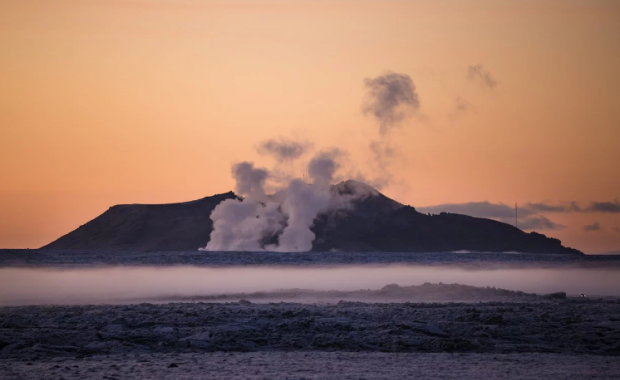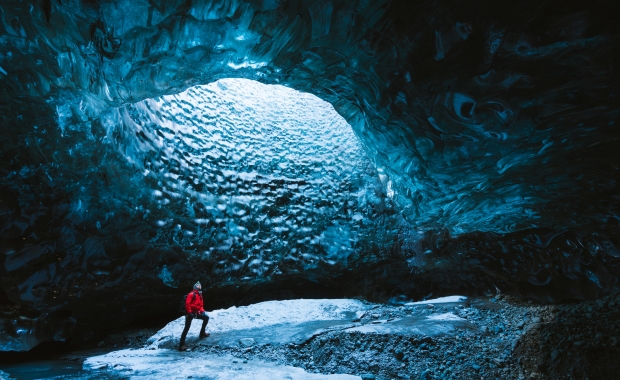Police as well as Search and Rescue teams fear it is only a matter of time before a major accident happens in Reynisfjara beach in South Iceland. Photos of a group of foreign visitors who narrowly escape being swept to sea by the incoming waves, which were shared on Icelandic social media yesterday, have prompted a discussion about the safety of travellers on the beach. Similar photos have been shared on numerous occasions in the past few years. In 2007 a US woman drowned as she was swept to sea by an incoming wave on the beach.
The chief of Police in South Iceland, Sveinn Kristján Rúnarsson, tells the Icelandic National Broadcasting Service RÚV that something must be done: “This cannot go on like this.” Sveinn tells RÚV that the authorities have done much to improve the safety of travellers on the beach. Warning signs were installed along the walking path to the beach, and a rope fence put down around the parking lot, to ensure all travellers would pass down the same path to the beach, thus walking past the warning signs.
“But that does not seem to change the fact that people go down there to play at the water’s edge, getting themselves into danger.” Ragnar points out that Reynisfjara has become one of the most popular tourist destinations in Iceland, but due to the danger and the unwillingness of visitors to heed written warnings, it is probably necessary to post a guard by the beach to keep visitors in check.
Read more: Photos: Travellers in grave danger on Reynisfjara beach, narrowly escape being swept away by waves
Smári Sigurðsson, the chairman of ICE-SAR, the Icelandic Association for Search and Rescue, similarly tells the local newspaper Morgunblaðið something must be done in response to the repeated news of travellers narrowly escaping danger in Reynisfjara. He points out that ICE-SAR units have repeatedly been called to assist travellers in danger in Reynisfjara. “This is a popular destination, and not all visitors are there accompanied by a local guide. I don’t like bans, but if the warning signs don´t work we might have to introduce some sort of live monitoring.”
Police as well as Search and Rescue teams fear it is only a matter of time before a major accident happens in Reynisfjara beach in South Iceland. Photos of a group of foreign visitors who narrowly escape being swept to sea by the incoming waves, which were shared on Icelandic social media yesterday, have prompted a discussion about the safety of travellers on the beach. Similar photos have been shared on numerous occasions in the past few years. In 2007 a US woman drowned as she was swept to sea by an incoming wave on the beach.
The chief of Police in South Iceland, Sveinn Kristján Rúnarsson, tells the Icelandic National Broadcasting Service RÚV that something must be done: “This cannot go on like this.” Sveinn tells RÚV that the authorities have done much to improve the safety of travellers on the beach. Warning signs were installed along the walking path to the beach, and a rope fence put down around the parking lot, to ensure all travellers would pass down the same path to the beach, thus walking past the warning signs.
“But that does not seem to change the fact that people go down there to play at the water’s edge, getting themselves into danger.” Ragnar points out that Reynisfjara has become one of the most popular tourist destinations in Iceland, but due to the danger and the unwillingness of visitors to heed written warnings, it is probably necessary to post a guard by the beach to keep visitors in check.
Read more: Photos: Travellers in grave danger on Reynisfjara beach, narrowly escape being swept away by waves
Smári Sigurðsson, the chairman of ICE-SAR, the Icelandic Association for Search and Rescue, similarly tells the local newspaper Morgunblaðið something must be done in response to the repeated news of travellers narrowly escaping danger in Reynisfjara. He points out that ICE-SAR units have repeatedly been called to assist travellers in danger in Reynisfjara. “This is a popular destination, and not all visitors are there accompanied by a local guide. I don’t like bans, but if the warning signs don´t work we might have to introduce some sort of live monitoring.”







